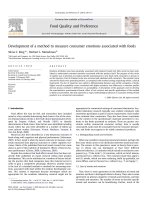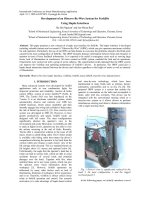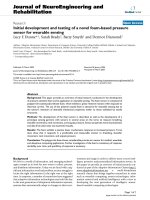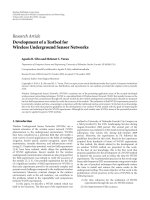Development of a micro composite wire MEG sensor
Bạn đang xem bản rút gọn của tài liệu. Xem và tải ngay bản đầy đủ của tài liệu tại đây (2.7 MB, 144 trang )
DEVELOPMENT OF
A MICRO COMPOSITE WIRE MEG SENSOR
OH TZE BENG
(B Eng (Hons). NUS)
A THESIS SUBMITTED
FOR THE DEGREE OF MASTER OF ENGINEERING
DEPARTMENT OF MECHANICAL ENGINEERING
NATIONAL UNIVERSITY OF SINGAPORE
2003
ACKNOWLEDGEMENT
First and foremost, the author would like to express his most sincere appreciation
to his Project Supervisor A/P. Li Xiaoping for his support, advice and
encouragement that he had extended throughout his Masters Research Project. His
assistance in the analysis and evaluation of the design had been most invaluable.
Under his guidance, the author had gained much knowledge in designing and
developing the sensor and a better understanding on project management.
The author also wishes to express his sincere gratitude to Dr Zhao Zhen Jie,
Research Fellow of Neurosensors Laboratories, for his patient guidance and time;
He has provided him with much insightful advice and guidance both on the
technical aspect of the project as well as management of the project that would
serve to be very beneficial in the future.
Furthermore, the author would like to express his utmost gratitude to the students
in Neurosensors Laboratories, namely Mr Seet Hangli, Mr Neo Boon Hwan for
their kind assistance and contributions to make this project a success.
Last but not least, the author would like to thank those who have rendered their
help in one way or another for this project.
i
TABLE OF CONTENTS
Page
ACKNOWLEDGEMENT
(i)
TABLE OF CONTENTS
(ii)
LIST OF FIGURES
(v)
LIST OF TABLES
(vii)
NOMENCLATURE
(viii)
SUMMARY
(ix)
Chapter 1
INTRODUCTION
1
1.1
Problem
1
1.2
Motivation
2
1.3
Objective
2
1.4
Scope
3
LITERATURE REVIEW
5
2.1
Ferromagnetic Materials
5
2.2
Magnetization Processes
6
2.2.1
6
Chapter 2
2.3
Magnetic Domain
2.2.2 AC Magnetization Processes
7
Various Types of Magnetic Sensors
9
2.3.1
9
Magneto-Impedance (MI) Sensor
2.3.2 Fluxgate Sensor
15
2.3.3
18
Search Coil Sensor
Chapter 3 CDMPI SENSOR
3.1
CDMPI Sensor Design
9
20
ii
3.1.1 Working Principle
21
3.1.2
Capacitor for Circuit Resonance
22
3.2
Printed Circuit Board for CDMPI Sensor
22
3.3
MPI Sensing Element
23
3.4
Pickup Coil with N turns
25
MAGNETIC SHIELD
27
4.1
Main Construction Features
27
4.2
Performance Characteristics
31
EXPERIMENTAL SETUP & PROCEDURES
32
5.1
Overall Experimental Layout
19
5.2
Magneto-Impedance Measurement Testing
33
5.2.1
Experimental Setup
33
4.2.2
Measurement Procedures
34
Chapter 4
Chapter 5
4.3
4.4
Chapter 6
6.1
6.2
Sensitivity Measurement Testing
36
4.2.1
Experimental Setup
36
4.2.2
Measurement Procedure
37
Resolution Measurement Testing
39
4.2.1
Experimental Setup
39
4.2.2
Measurement Procedures
40
SENSING ELEMENT
43
Magneto-Impedance Testing
43
6.1.1
44
Experimental Results and Discussions
Effect of Magnetic Anisotropy on Sensitivity
and Resolution
47
6.2.1
Experimental Details
48
6.2.2
Experimental Results and Discussions
48
iii
Chapter 7
7.1
7.2
Chapter 8
8.1
8.2
AC DRIVING SOURCE
51
Effect of magnitude of input current on
sensitivity
51
7.1.1
Experimental Details
51
7.1.2
Experimental Results and Discussions
52
Effect of driving frequency on sensitivity
53
7.1.1
Experimental Details
54
7.1.2
Experimental Results and Discussions
54
LC RESONACE OF PICKUP COIL
56
Effect of capacitance on sensitivity and
resolution
56
8.1.1
Experimental Details
56
8.1.2
Experimental Results and Discussion
56
Effect of number of turns of coil on resolution
58
7.2.1
58
Experimental Details
7.2.2 Discussion
Chapter 9
CONCLUSION
REFERENCES
58
60
62
APPENDICES
APPENDIX A
66
APPENDIX B
69
APPENDIX C
97
APPENDIX D
101
APPENDIX E
112
APPENDIX F
115
iv
LIST OF FIGURES
Page
2.1
Domain Wall Displacements
7
2.2
Moment Rotation
7
2.3
Typical hysteresis loop of ferromagnetic materials
8
2.4
Voltage-amplitude Ew vs the external Hex characteristics in a zero
magnetostrictive amorphous wire magnetized with a 5mA current
of 1Mhz in (a) and 10MHz in (b)
11
2.5
Basic setup of a fluxgate sensor
16
2.6
Basic Search Coil sensor layout
19
3.1
Schematic diagram of CDMPI sensor
20
3.2
Layout of PCB for CDMPI sensor
23
3.3
Section view of MPI sensing element
24
3.4
Schematic Diagram for Conventional Electroplating
24
3.5
Schematic Diagram for Magnetic Controlled Electroplating
25
3.6
Fabrication Setup for Pickup Coil
25
4.1
Layer constructions. The longitudinal coil of 30 turns was wound
around the layer.
28
4.2
Flat rectangular transversal coils of 10 turns were fixed on a
flexible cardboard sheet and wound around the 3rd layer
29
Cross sectional view of multi-structure shell of the shielding
Isolating layers are 4 mm thick
30
5.1
Schematic Diagram for MI measurement set-up
34
5.2
Schematic diagram for sensitivity measurement set-up
37
4.3
v
Page
5.3
Schematic Diagram for resolution measurement set-up
40
6.1
MI curve obtained for Sample 1
44
6.2
Graph of ∆Z
46
6.3
(a) Circumferential (b) Longitudinal anisotropy structures
6.4
Graph of Vpp (mV) against Hext (Oe) to compare the sensitivity for
longitudinal and cirumferential anisotropies (Set A)
49
6.5
Z
(%) against Hext (Oe) at frequency of 50 MHz
47
Graph of Vpp (mV) against Hext (Oe) to compare the sensitivity for
longitudinal and cirumferential anisotropies ( Set B)
49
7.1
Effect of Input Voltage, VI on the sensitivity (Sample 1)
53
7.2
Graph of Sensitivity (mV/Oe) against fDR (MHz) (Sample 4)
54
8.1
Graph of Vpp (mV) against Hext (Oe) for different fCR values
56
vi
LIST OF TABLES
Page
2.1
Magnetic sensors and their detectable field range
9
5.1
Table of MPI sensing element samples used
32
6.1
Samples used for comparison on the effect of anisotropy
48
6.2
Sensitivity and Resolution for samples with different anisotropies 50
8.1
Effect of Capacitance on Sensitivity and Resolution of Sensor
56
8.2
Sensitivity and Resolution obtain for Sample 4 by varying N
58
vii
NOMENCLATURES
A
the cross-sectional area
φ
the magnetic flux in the coil
fCR
the resonance frequency of the LC circuit
fDR
the driving frequency of the sensing element
fMI
the optimum magneto-impedance (MI) ratio frequency
H
the magnetic field in the sensor core
Hext
the external DC magnetic field
µ0
the absolute permeability of open space
µr(t)
the sensor core relative permeability
N
the number of turns of the pickup coil
Vi
the voltage induced in a coil
VI
the input voltage
Vpp
the output peak to peak voltage
Z(Hext)
the impedance for the external DC magnetic field
Z(Hmax)
the impedance at the maximum field for 2500 mA
∆Z
the magneto-impedance (MI) ratio
Z
(∆Z Z )
max
the maximum magneto-impedance (MI) ratio
viii
SUMMARY
A portable brain activity monitoring device is very versatile as it can be
used in many applications like in the medical field for brain mapping using MEG,
preventing the occurrence of accidents caused by drivers falling into sleep or for
non-contact detection of pilot in-flight blackout. However, such a device requires
a magnetic sensor with an extremely high sensitivity, which poses a great
challenge to its portability.
The main objective is to develop a high sensitivity micro-sensor which can
be used in a portable brain activity monitoring device. A novel micro magnetic
sensor called Current Driven Magnetic Permeability Interference (CDMPI) sensor
has been developed for this purpose. This sensor has a sensing element made of a
composite micro-wire core which is plated with a thin layer of soft ferromagnetic
material (Ni80Fe20). This material has a high permeability such that it can be
magnetized very easily in the presence of a weak magnetic field. By making use
of the interference in the magnetic permeability when a sinusoidal current is
passed into the sensing element which in the presence of an external D.C.
magnetic field, an output voltage is induced across the pickup coil. Next, a
capacitor is connected across the pickup coil so that a circuit resonance is
introduced into the sensor and thereby increases the sensitivity of the sensor. The
output peak-to-peak voltage across the LC circuit, which is proportional to the
magnetic field, is then measured.
Experimental studies on the CDMPI sensor have been carried out to see
how the various parameters influence the sensitivity and resolution of the sensor.
ix
From the experimental results, it has been found that for the range of 0 Oe to
0.695 Oe; it is able to achieve a maximum sensitivity of 2273.7 mV/Oe and a
maximum resolution of 7.0 × 10 −9 T. The requirements needed for the sensor are
as follows. Firstly, an optimum input voltage should be used to drive the MPI
sensing element while maintaining a second harmonic output voltage signal from
the sensor. Secondly, the sensor must be operated at the critical frequency
condition whereby fDR = fCR = fMI. Next, the sensing element should be one that
has longitudinal anisotropy. Finally, the number of turns of the pickup coil, N
needs to be as large as possible because it has been found that as N is increased;
the resolution of the sensor will also be improved.
In summary, a micro composite magnetic sensor is developed and the various
parameters affecting the sensitivity and resolution are tested and discussed in this
research project. Optimum parameters are also proposed to make a high
sensitivity magnetic sensor.
x
Chapter 1
INTRODUCTION
It has long been known that activities of cells and tissues generate electrical fields
which can be detected on the skin surface, and also corresponding magnetic fields
in the surrounding space. One example of such a phenomenon is observed in a
human brain whereby a neuron in the brain actually causes a current to flow
within the brain, producing an electric potential difference on the scalp, and hence
generating a weak magnetic field around the brain. These electric and magnetic
field
can
be
measured
by
electroencephalography
(EEG)
and
magnetoencephalography (MEG) respectively. Magnetoencephalography (MEG)
is completely non-invasive, non-hazardous technology for functional brain
mapping by measuring the associated magnetic fields emanating from the brain.
By making use of such a technique, it is possible for people to monitor their brain
activities. This is essential as it will improve the qualities of human life, such as
improving the qualities of sleeping through the studying of physics of sleep,
preventing the occurrence of accidents caused by drivers falling into sleep as well
as for non-contact detection of pilot in-flight blackout. The activities of the human
brain can be detected by using appropriate magnetic field detectors.
1.1
Problem
Currently, there are many available sensors in the market that are capable of
detecting magnetic field. Some popular magnetic sensors are the Hall Effect
magnetic sensors, Giant Magneto-resistive (GMR) sensors, Giant MagnetoThe National University of Singapore - Department of Mechanical Engineering
1
Chapter 1
INTRODUCTION
impedance (GMI) sensors, Fluxgate sensors and the Superconducting Quantum
Interference Device (SQUID). At present, only the SQUID is capable of detecting
biomagnetic fields that are generated by the brain which vary from 10-12 to 1014
Tesla. However, the use of the SQUID magnetometer is limited by its high costs
and huge space required due to its size and equipment required. In view of this
problem of cost and space, there is a need for the development of a high
sensitivity and resolution micro-sensor that can be used in a portable brain activity
monitoring device for real time monitoring.
1.2
Motivation
The detection of real time human brain activities will significantly improves the
lives of many people. Potential areas of applications include fundamental research
for the brain, neural clinic measurements and individual daily brain activity
monitoring, such as sleep onset monitoring. These wide applications that are
possible with the development of a micro bio magnetic sensor will greatly
enhance the quality of living and hence provide the motivation behind this
Research Project.
1.3
Objective
The objective of the project is to design and develop a high sensitivity and
resolution micro-sensor capable of measuring extremely weak magnetic fields.
During the development of the sensor, experimental studies will be performed to
test the sensitivity and resolution of the sensor. In the above mentioned
The National University of Singapore - Department of Mechanical Engineering
2
Chapter 1
INTRODUCTION
experimental studies, investigations will be carried out to analyze the effects of
varying the sensing element parameters, a.c. driving source parameters and the
pickup circuit parameters in relation to the sensitivity and resolution of the sensor.
Details of each of the parameters investigated are as follows:
Sensing Element Parameters
1. Effect of the optimum magneto-impedance (MI) ratio frequency, fMI on the
sensitivity and resolution of the sensor.
2. Effect of the magnetic anisotropy on the sensitivity and resolution of the
sensor.
AC Driving Source Parameters
1. Effect of the magnitude of input current across the sensing element on the
sensitivity of the sensor.
2. Effect of the frequency of driving current across the sensing element on
the sensitivity of the sensor.
Pickup Circuit Parameters
1. Effect of circuit resonance on the sensitivity and the resolution of the
sensor by changing
1.4
the number of turns of the pickup coil, N
the capacitance of the parallel capacitance of the circuit.
Scope
This research project seeks to develop portable micro-biomagnetic sensors by
designing and developing a micro sensor with the capabilities of measuring very
The National University of Singapore - Department of Mechanical Engineering
3
Chapter 1
INTRODUCTION
weak magnetic fields. In order to achieve such sensors, three key areas will be
studied and analyzed. They are the magnetic properties of the sensing element, the
a.c. driving current and the pickup circuit of the Current Driven Magnetic
Permeability Interference (CDMPI) sensor. Detailed evaluations will then be
brought forth and discussed and recommendations for the design improvement
will be proposed.
The organization of this thesis is as follows. In the next chapter, a literature survey
is done to verify the novelty of the idea as well as provide background
information on the current developments on magnetic sensors for weak magnetic
fields. In Chapter 3, the design of the Current Driven Magnetic Permeability
Sensor (CDMPI) sensor will be illustrated and its working principle will be
explained in details. This is followed by a chapter on the newly designed magnetic
shield. Chapter 5 displays the experimental setups involved and the procedures
used for the measurement of the sensitivity and resolution of the sensor. Chapter 6
covers the experimental studies of the sensing element in extensive details,
followed by another investigation of the other two components of ac driving
current and pickup coil in Chapter 7 and 8 respectively. Analysis and discussions
will also be addressed under these respective chapters. This is followed by
conclusions in Chapter 9.
The National University of Singapore - Department of Mechanical Engineering
4
Chapter 2
LITERATURE REVIEW
In this chapter, relevant theories on the ferromagnetic materials are examined.
Detailed background information of the three types of magnetic sensors that are
able to sense the magnetic field through the interference in the magnetic
permeability of the sensing element will also be presented. In this chapter, a brief
introduction into the working principles of these magnetic sensors through various
papers and references will also be given.
2.1
Ferromagnetic materials
Ferromagnetism is a distinctive magnetic behaviour that is seen in metals like
iron, nickel, cobalt and manganese, or their compounds and some of the rare
earths like gadolinium, dysprosium) when a magnetizing force is applied to
increase the magnetic flux associated with the material, but there exists a
saturation point for most of the magnetic materials beyond which the associated
magnetic flux does not increase. This condition is referred to as magnetic
saturation [1]. The magnetic properties of ferromagnetic materials come from the
motion of electrons in the atoms. Each electron has a magnetic (spin) moment. For
a single atom in isolation there is a definite magnetic moment, which may be
ascribed to a conceptual atomic magnet [2].
Ferromagnetic materials exhibit a long-range ordering phenomenon at the atomic
level, which causes the unpaired electron spins to line up parallel with each other
in a region called a domain. Within the domain, the magnetic field is intense, but
The National University of Singapore - Department of Mechanical Engineering
5
Chapter 2
LITERATURE REVIEW
in a bulk sample the material will usually be unmagnetized because the many
domains will themselves be randomly oriented with respect to one another.
Ferromagnetic materials will tend to stay magnetized to some extent after being
subjected to an external magnetic field. This tendency to "remember their
magnetic history" is called hysteresis (see Figure 2.3). The fraction of the
saturation magnetization, which is retained when the driving field is removed, is
called the remanence of the material [3].
Generally, ferromagnetic materials can be separated into two groups and they are
magnetically hard and magnetically soft. For soft materials, they have high
permeability, and are easily magnetized and demagnetized. However, for hard
materials once they are magnetized, they cannot be demagnetized easily. Since,
magnetically soft materials are the ideal choice for magnetic sensor because for a
sensor to be sensitive, it must have high permeability and it must be easy to be
magnetized.
2.2
Magnetization Processes
2.2.1 Magnetic Domain
By application of a field on a ferromagnetic material, the entire domain wall
structure becomes mobile, at first slowly then, with increasing magnetic field
strength, in large jumps. Those domains, in which the spontaneous magnetization
happens already to lie roughly in the direction of the lines of the magnetic field,
grow by wall displacements at the expense of the other domains. This process is
The National University of Singapore - Department of Mechanical Engineering
6
Chapter 2
LITERATURE REVIEW
called domain wall displacement. (Figure 2.1) The high permeability of soft
magnetic materials is due to the easy domain wall displacements.
Hext
Hext
Without Field
With Field
Figure 2.1 Domain Wall Displacements
Without Field
With Field
Figure 2.2
Moment Rotation
The other magnetization process that occurs on magnetization of a ferromagnetic
metal is the moment rotation. It occurs by means of which the atomic magnets of
a whole domain align themselves simultaneously in the field direction under the
influence of the magnetic field. (Figure 2.2) However, this rotational process
demands relatively high field strengths. With soft magnetic metals, the wall
displacements usually take place in the whole metal first before the spontaneous
magnetization of a domain can either rotate or snap into field direction by means
of a moment rotation. [4]
2.2.2 AC Magnetization Processes
A good permanent magnet should produce a high magnetic field with a low mass,
and should be stable against the influences which would demagnetize it. The
desirable properties of such magnets are typically stated in terms of the remanence
and coercivity of the magnet materials.
The National University of Singapore - Department of Mechanical Engineering
7
Chapter 2
Figure 2.3
LITERATURE REVIEW
Typical hysteresis loop of ferromagnetic materials
When a ferromagnetic material is magnetized in one direction, it will not relax
back to zero magnetization when the imposed magnetizing field is removed. The
amount of magnetization it retains at zero driving field is called its remanence. It
must be driven back to zero by a field in the opposite direction; the amount of
reverse driving field required to demagnetize it is called its coercivity. If an
alternating magnetic field is applied to the material, its magnetization will trace
out a loop called a hysteresis loop (see Figure 2.3). The lack of retraceability of
the magnetization curve is the property called hysteresis and it is related to the
existence of magnetic domains in the material as mentioned earlier.
The hysteresis loop above is plotted in the form of magnetization M as a function
of driving magnetic field strength H. This practice is commonly followed because
it shows the external driving influence (H) on the horizontal axis and the response
of the material (M) on the vertical axis.
In this thesis, the area of interest is magnetically soft ferromagnetic materials in
which the magnetic field can be easily reversed. A magnetically soft material
The National University of Singapore - Department of Mechanical Engineering
8
Chapter 2
LITERATURE REVIEW
generally has high permeability but very small coercivity. This will lead to them
having very narrow hysteresis loops.
2.3
Various Types of Magnetic Sensors
As there are many different types of magnetic sensors, the following table shows
the various magnetic sensors and their resolution range.
Table 2.1
Magnetic sensors and their detectable field range
2.3.1 Magneto-Impedance (MI) Sensor
Recently, magneto-impedance (MI) phenomena have attracted much interest
because of their potential for applications in micro sensors. [5] The magneto
impedance effect found in amorphous wires with soft magnetic properties in 1992
is noticeable as a new principle for sensing magnetic field. According to this
effect, the impedance of the soft magnetic materials in the range of high
frequencies changes remarkably with the external magnetic field. This effect is
The National University of Singapore - Department of Mechanical Engineering
9
Chapter 2
LITERATURE REVIEW
expected to be promising for magnetic field sensors with high sensitivity. This
giant magneto-impedance (GMI) effect consists of the large relative change of the
impedance (up to 300%) observed in under the application of dc magnetic field
(units of kAm-1) [5]. Considering the different magnetic anisotropies
(circumferential or helical in a wire, a transverse in a film/ribbon), various types
of GMI characteristics can be obtained; having a maximum or a minimum at zero
external field, without a hystersis or exhibiting a sharp bistable hystersis,
symmetrical with respect to the field. This suggests great technological potential
of GMI in a wide range of sensor applications. [5]
Working Principle
In Giant Magneto Impedance (GMI), it is the materials complex impedance that
super drastic changes as a function of the applied magnetic field. The overall
effect of the magnetic field application in the case of GMI is to induce strong
modifications in the effective magnetic permeability, a factor which is relevant to
determine the field and current distribution within the samples. When a soft
magnetic material is used, the magnetic permeability can change orders of
magnitude when a rather small field is applied, causing strong variations in the
internal fields and electrical current density, and consequently, on the sample’s
impedance. The effect is strongly dependent on the frequency of the applied
current and the magnetic anisotropies present in the material, which spawns a
number of interesting new magnetic phenomena. [6]
A deeper understanding of the mechanism behind GMI allows one to predict some
The National University of Singapore - Department of Mechanical Engineering
10
Chapter 2
LITERATURE REVIEW
expected behaviors, under particular assumptions, and to use the GMI as an
additional tool to investigate some intrinsic and extrinsic magnetic properties of
novel artificially grown soft magnetic materials. A typical MI setup and results is
as shown in the Figure 2.4 below.
Figure 2.4
Voltage-amplitude Ew vs the external Hex characteristics in a
zero-magnetostrictive amorphous wire magnetized with a 5mA
current of 1Mhz in (a) and 10MHz in (b)
Materials
GMI was first reported in amorphous metals, but some crystalline materials also
exhibit large GMI. Sometimes the crystalline metals are even better than the
amorphous ones. According to theory, the largest GMI should be in materials with
low resistivity,ρ, high saturation magnetization, Ms, and low damping parameter,
α. The crystalline metals have the advantage of lower resistivity, but amorphous
metals have better soft magnetic behavior because they lack magnetocrystalline
anisotropy. Nonmagnetostrictive materials show the best GMI performance
because the magnetoelastic contribution to magnetic anisotropy substantially
deteriorates
the
soft
magnetic
behaviour.
Amorphous
The National University of Singapore - Department of Mechanical Engineering
cobalt-rich
11
Chapter 2
LITERATURE REVIEW
ribbons/film/wires, and glass-covered microwires [6] are good candidates for GMI
applications. These materials have the advantages of low magnetostriction and
simple control of magnetic anisotropy by appropriate heat treatment; the
disadvantage is high resistivity. Soft magnetic nanocrystalline metals exhibit GMI
behavior similar to amorphous metals. Their somewhat higher Ms and lower
resistivity ρ, can lead to small improvements. The low resistivity and bulk
dimensions of crystalline soft magnetic alloys lead to better performance,
especially at lower driving frequencies below 1 MHz. The presence of large
magnetocrystalline anisotropy (e.g., in iron-silicon alloys), however, requires a
rough texture of crystalline grains and proper adjustment of the driving current
and the directions of the dc bias field [7].
Combined conductors comprising a highly conductive nonmagnetic metal core
(such as Cu or CuBe) with a thin layer of soft magnetic metal on the surface have
excellent GMI behavior [8]. An insulating interlayer between the core and the
magnetic shell, in sandwich thin-film structures, results in further improvement of
GMI behavior. Integrated circuits and glass-covered microwires can incorporate
these thin-film structures.
Different forms of MI Sensors
MI effect has been found in three forms namely, (1) Magnetic amorphous soft
ribbon and wire (2) Magnetic composite wires (3) Magnetic composite thin films
The National University of Singapore - Department of Mechanical Engineering
12
Chapter 2
LITERATURE REVIEW
Magnetic amorphous soft ribbon and wire
The most basic of MI elements consist of amorphous wires with soft magnetic
properties characterized by nearly vanishing magnetostriction and a well-defined
anisotropy [9,10,11]. For example, (Co0.94Fe0.06)72.5Si12.5B15 amorphous wire has
an almost zero magnetostriction of 10-7 and the change of voltage (or impedance)
with the application of an axial field can be as much as 10~100% /Oe at MHz
frequencies. Such sensitivity can be obtained even in a small sample of 1mm
length and a few micrometers diameter [12]. Amorphous alloy ribbons with
excellent soft-magnetic properties are widely used as core materials nowadays
[13].
Magnetic composite wires
Magnetic composite wire consists of a nonferromagnetic inner core and
ferromagnetic shell layer the amplitude of the GMI effect has raised considerably
when the conductivity of the inner core is much larger than that of the shell region
[11]. Excellent MI effects have been observed in a non-magnetic BeCu wire of
diameter 125µm plated with a thin layer of soft ferromagnetic Ni80Fe20 permalloy
of thickness 1µm [8]. For drive currents of order 100mA and frequencies of the
order of 5MHz, the field sensitivity can go as large as 1V/Oe (per cm of the wire).
Recent studies have extraordinary high (up to 800% magnetoimpedance ratio) and
sensitive magnetoimpedance effect has been found in FeCoNi magnetic tubes
electroplated onto BeCu nonmagnetic wire at frequency of about 1Mhz order [14].
Magnetic composite thin films
The National University of Singapore - Department of Mechanical Engineering
13
Chapter 2
LITERATURE REVIEW
MI is also observed in multilayers consisting essentially of two ferromagnetic
layers (F) which sandwich a non-magnetic highly conductive layer (M): F/M/F.
For a considerable conductivity difference between the layers, the inductance of
the magnetic films gives the main contribution to the system impedance at
relatively low frequencies [9]. For example, in CoSiB/Cu/CoSiB films of 7-µm
thick, the MI ratio is 340% for a frequency of 10MHz and a DC magnetic field of
9Oe. A considerable enhancement of the MI effect in multilayers can be achieved
by insulator separation between the conductive lead and the magnetic films. With
the addition of a SiO2 insulation, the multiplayer structure of the composition
CoSiB/SiO2/Cu/SiO2/CoSiB exhibits a MI ratio of 620% for 11Oe. Changing the
inner lead material to a material of smaller resistivity (1.62µΩ) will result in a MI
ratio of 440%.
Resolution of MI Sensors
Amorphous Wire
Magnetic sensors based on MI in amorphous wires have been recently developed,
which demonstrates the filed detection resolution of 10-6 Oe (10-10 Tesla) for the
full scale of +- 1.5-2Oe with the sensor head length of 1mm [10]. This micro
sensor having a micro-sized zero-magnetostrictive amorphous wire head of about
1mm installed in self-oscillation circuits such as the Colpitts oscillator and a
multivibrator circuit shows a high sensitivity with a resolution of 10-6 Oe for ac
field and 10-5 for dc fields, quick response with a cut-off frequency of about
1MHz, and a high temperature stability of less than 0.05%FS oC-1 up to 70oC.
The National University of Singapore - Department of Mechanical Engineering
14









